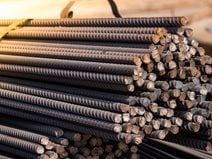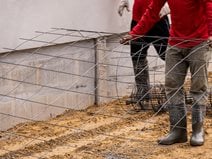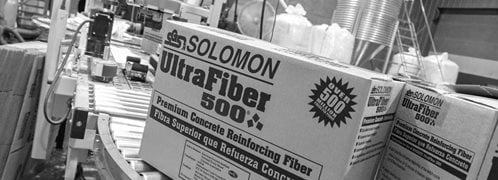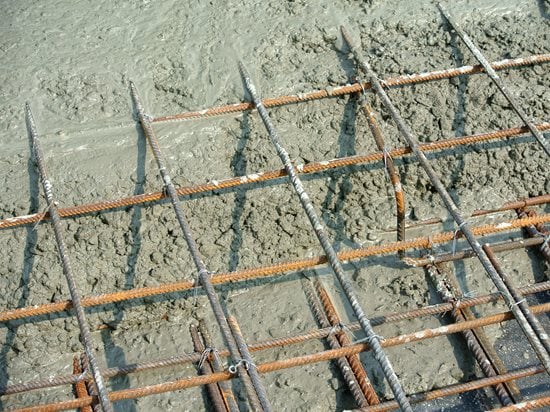- Concrete slabs home
- Use a low water-cement ratio: How to calculate
- Subgrades and subbases for concrete slabs: Tips for ensuring good support
- Concrete Slab Finishing Tips
- DIY Slab Mistakes to Avoid
- How to Prevent Cracks
- Guidelines for preventing cracks in concrete slabs
- Be active in deciding where control joints will be placed
- Reinforcing Concrete Slabs
- Proper Curing of Concrete Slabs
- Properly curing concrete slabs: Why and how
- Related Information:
- Concrete fasteners
- Concrete forms
- The three types of concrete foundations
- Aggregates in ready-mix concrete
- Vapor barriers for concrete slabs
- Post-tensioned concrete slabs
- Concrete slabjacking
- Concrete testing
A Guide to Reinforcing Concrete Slabs
Learn why reinforcing a decorative concrete slab is important and take a look at the various reinforcement options.If you plan on installing a new decorative concrete driveway, patio, sidewalk, or floor slab, what you use to reinforce it is almost as important as the concrete itself. There are a number of reinforcing materials for concrete slabs, and each type has its pros and cons, depending on the application. Here’s an overview of your options along with tips on how to choose the best type of reinforcement for your next concrete project.
Why Do Concrete Slabs Need Reinforcement?
Concrete slabs are high in compressive strength, which makes them great at resisting compression forces and impact. But when it comes to tensile strength, or the capacity to resist pulling-apart forces, concrete doesn’t fare as well. In fact, the tensile strength of concrete is only about 15% of its compressive strength.
That’s why many concrete slabs require some type of reinforcement. It provides the tensile strength that concrete lacks to help it withstand tension forces caused by subgrade settlement, heavy loads, drying shrinkage, and thermal expansion and contraction. Reinforcement doesn’t actually prevent cracks from forming in concrete, but it does help limit the width and severity of cracking if it does occur, potentially saving you lots of money on repair work down the road.
What Are My Reinforcement Options?
A variety of materials can be used to boost the tensile strength of concrete. They are classified as either primary reinforcement, such as steel rebar or welded wire fabric, or secondary reinforcement, which is used to minimize the effects of plastic shrinkage and thermal expansion and contraction.
 Guiderom / Shutterstock
Guiderom / Shutterstock
Steel Reinforcing Bars
Commonly called “rebar,” these 1/2-inch-diameter steel rods are embedded in the center of the slab to create a grid that extends lengthwise and crosswise to help the concrete better resist pulling and bending forces. Ridges in the surface of the rebar allow the concrete to adhere to it and create one solid structure. Carbon steel rebar (also called black rebar) is the type used for most residential projects. Stainless steel rebar is also available, but is higher in cost and generally reserved for projects where corrosion is a major concern.
 RDun / Shutterstock
RDun / Shutterstock
Epoxy-Coated Rebar
These are steel rebar completely covered in a coating of epoxy to minimize the chances of corrosion. Higher in cost than simple steel bars (but less expensive than stainless steel), they are typically used for slabs in marine environments or that are regularly exposed to deicing salts.
 wiroj Roudkhlay / Shutterstock
wiroj Roudkhlay / Shutterstock
Welded Wire Fabric
Also called welded wire mesh, this type of reinforcement is made from steel wires arranged at right angles to each other and electrically welded where they intersect. It is often used as an alternative to steel rebar in residential concrete slabs because the wire fabric can be placed more quickly than individual bars, which reduces the overall cost.
 TopFotography / Shutterstock
TopFotography / Shutterstock
Synthetic Fibers
A type of secondary reinforcement consisting of small polypropylene or polyethylene fibers (typically less than 0.12 inch in diameter) that are mixed right into the concrete as a way to reduce plastic shrinkage cracks. Although synthetic fibers will not provide structural reinforcement, like reinforcing steel, they will improve concrete’s flexural strength and resistance to abrasion and impact. (See Using Fibers for Secondary Reinforcement.)
 Brickform Ultra-M1x
Add color and fiber with one product
Brickform Ultra-M1x
Add color and fiber with one product
 Rescue-Pak
Contains six of the most effective admixtures
Rescue-Pak
Contains six of the most effective admixtures
 UltraFiber 500®
Will not ball or fuzz, accepts color
UltraFiber 500®
Will not ball or fuzz, accepts color
Pros and Cons of Different Types of Concrete Reinforcement
Reinforcing concrete with steel rebar or welded wire mesh provides many benefits including crack control, the need for fewer control joints, and increased structural strength and impact resistance. However, the steel must be properly positioned at or just above the mid-depth of the slab to be effective and to avoid problems such as rebar shadowing and rust stains on the concrete surface if the metal becomes exposed to moisture due to cracking or damage.
Synthetic fibers won’t rust or corrode, but they are no substitute for steel reinforcement in concrete slabs that will be supporting heavy loads. There’s also the chance that the fibers will be visible on the concrete surface, like fine hairs or fuzz, although proper finishing will usually prevent that problem. On the plus side, synthetic fibers are the best type of reinforcement for reducing the possibility of plastic shrinkage cracking because they are mixed into the fresh concrete before placement. Each fiber acts as a mini reinforcing element to provide localized tensile strength throughout the entire slab.
What Type of Reinforcement Should I Use?
The answer to this question generally depends on the purpose of the concrete slab and your budget. Using steel reinforcement will give your concrete slab additional structural capacity and is especially important for a driveway that will be expected to support large trucks or heavy traffic. But for the typical residential concrete driveway, patio or sidewalk, wire mesh is a great (and less expensive) alternative.
If aesthetics are a priority and you are concerned about plastic shrinkage cracking marring the appearance of the concrete surface, consider using synthetic fibers in your slab in addition to or instead of steel reinforcement. Synthetic fibers will also give your concrete increased resistance to abrasion, shattering, and impact forces.
Concrete with Reinforcement
Is more resilient to tensile stresses caused by settlement, heavy loads, and thermal expansion and contraction.
Is less likely to crack and has increased structural strength and impact resistance.
Remains more aesthetically pleasing because it is less susceptible to cracking, shrinkage, and abrasion.
Often costs more to install, but the payoff is more durable concrete with a longer lifespan.
Concrete without Reinforcement
Has good compressive strength but lacks tensile strength to resist pulling forces.
May bow under tension, which will lead to unsightly cracks and more frequent repairs.
May require extensive crack repair, which will be difficult, if not impossible, to disguise.
On some projects, reinforcement is unnecessary and not worth the extra expense. Consult with your concrete contractor.
Do Concrete Slabs Always Need Reinforcement?
You should think of reinforcement as low-cost insurance against the risk and severity of concrete cracking, but it may not be required for every project. As a general rule of thumb, if you are pouring a concrete slab that is more than 5 inches in depth, you should install rebar or welded wire fabric to preserve its structural integrity, especially if the concrete will be exposed to heavy loads. But for many slabs placed on well-compacted subbases and with control joints installed at proper the spacing, reinforcement is unnecessary. Before installing any type of decorative concrete slab, be sure to discuss your reinforcement options with your concrete contractor.





